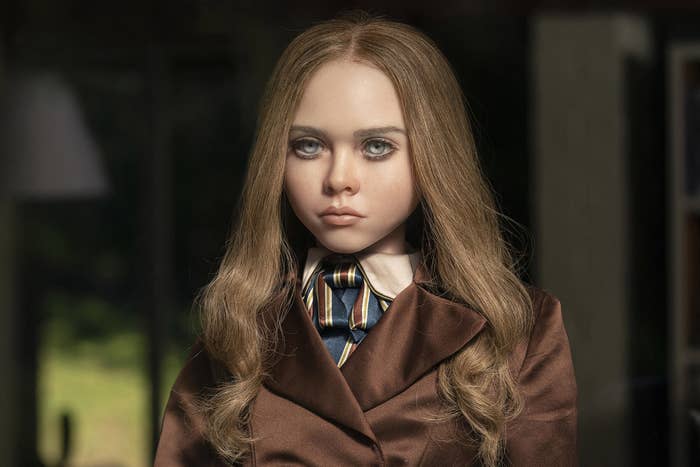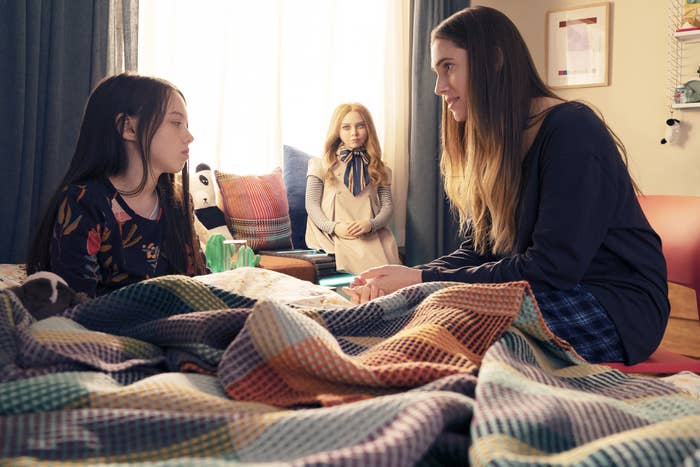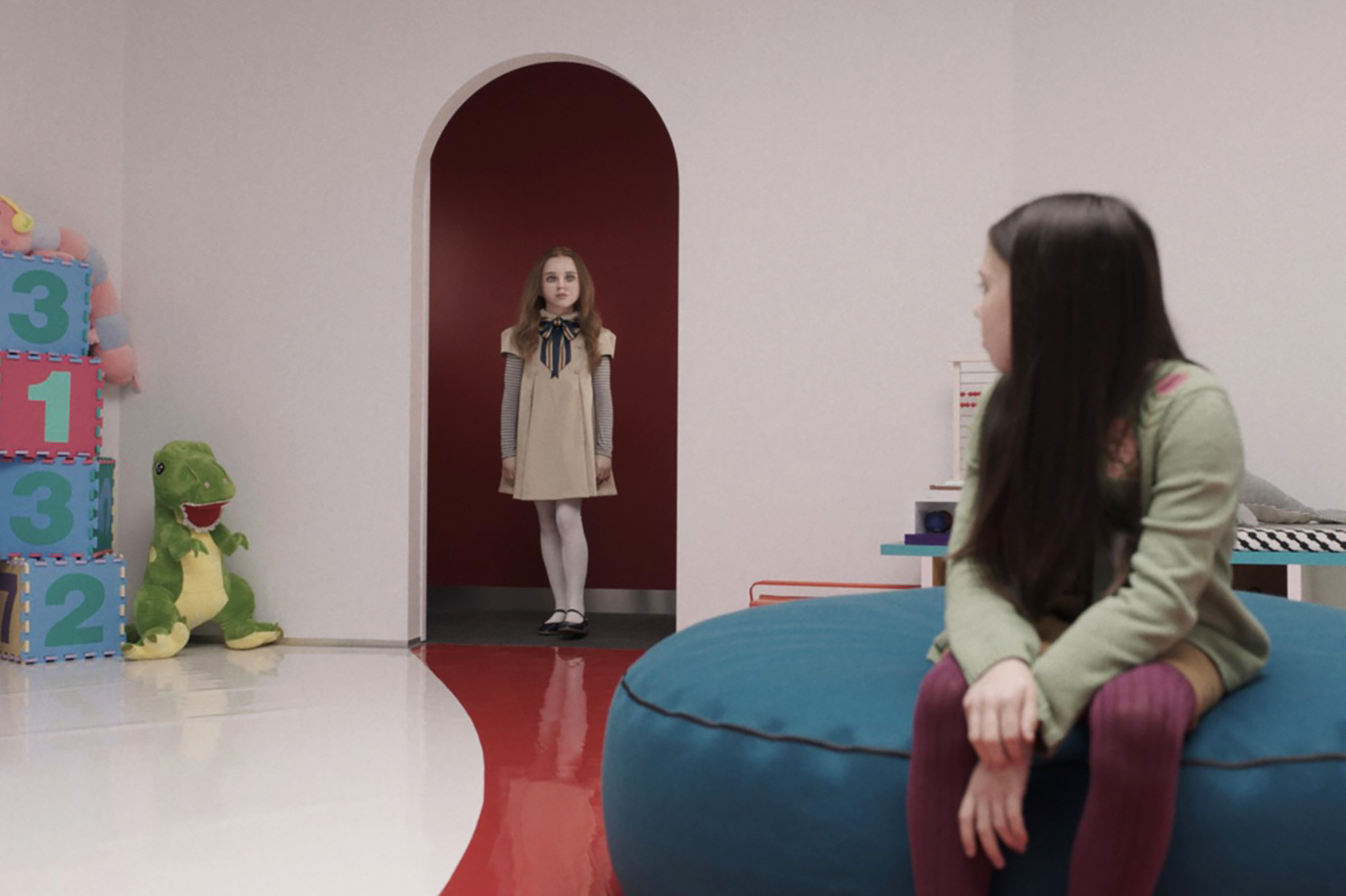
Credit where it’s due: The marketing team behind the new horror movie M3GAN has done an excellent job. It’s been easy enough to rake in the horror fans; M3GAN is a trifecta of evil. She’s an oversize talking doll, à la Chucky of 1988’s Child’s Play. She’s a glowering, well-dressed little girl, à la the twins from 1980’s The Shining. And she’s a robot taking on a mind of her own, à la 1986’s Short Circuit. She is three classic horror and sci-fi tropes rolled into one. It is her genre-given destiny to fuck things up. And given that her mind is a computer with access to the entire history of human knowledge, she probably knows it too!
But the particular genius of the M3GAN marketing team has been in its incorporation of apt pop culture references. The first trailer, which dropped last October, is set to an eerie version of “It’s Nice to Have a Friend” by Taylor Swift, automatically earning the allegiance of millions of Swifties. It features a scene where M3GAN does a contemporary dance down a hallway on her way to kill someone, twirling in her stockings and Mary Janes with the look of a stone-cold killer on her silicone face. Within hours of its release, viewers swarmed TikTok and Twitter to make fan edits setting this scene to “Hot Girl” by Charli XCX and declare M3GAN an instant gay icon. The second trailer is set to “Dolls” by Bella Poarch, a Gen Z icon of high femme body horror. Conveniently, the chorus of her song goes, “Dolls kill,” which is both the literal plotline of M3GAN and a sly, sideways little reference to a rave-forward fast-fashion brand popular in New York, LA, and San Francisco.
It’s a crisscrossed web of pop culture references designed to cement M3GAN’s cultural relevance amid a specific niche of highly online, campy young people. The M3GAN team has been targeting the kind of people who would declare the Babadook a gay icon, and they’ve hit the mark exactly.

But because “killer robot doll” is merely a vibe and not a premise for a feature-length film, here’s the basic plot of M3GAN, which comes out tomorrow: M3GAN, which stands for “Model 3 Generative Android,” is the secret side project of roboticist Gemma (Allison Williams). Gemma works at Funki, a high-tech toy company, where she has been assigned to work on its most popular product: PurRpetual Petz, iPad-controlled Furbies that shit physical pellets when you feed them digital food. But when she adopts her newly orphaned niece, Cady (Violet McGraw), Gemma realizes that she’s not cut out for parenting. Ignoring her directive to create a cheaper prototype of PurRpetual Petz, Gemma fast-tracks M3GAN in the hopes that the doll can be Cady’s friend and de facto mom.
It is her genre-given destiny to fuck things up.
Soon enough, Gemma debuts M3GAN: a robot designed to mimic Cady’s speech and behavior patterns and protect her from harm who is programmed to get better at her job as she spends more time studying Cady and the world. Even Gemma’s PurRpetually dissatisfied boss, David (Ronny Chieng), is impressed, and he agrees to abandon the Petz project in favor of making M3GAN public. Gemma just needs to keep M3GAN under wraps for two weeks, at which point Funki will unveil its new invention to the world. What could go wrong?
How about a killing spree? At first, M3GAN kills to protect Cady, but then she gets so creative with her murders that she seems to actually be enjoying herself. The movie thrives in this wheelhouse, once it gets past the pesky exposition into the part it knows we’ve all been waiting for: M3GAN’s escalating antics of wild, bitchy villainy. The best scenes in the movie are the ones where Gemma trots M3GAN out in front of Funki execs to prove how innovative her technology is. As M3GAN performs for two audiences, one real and one fictional, the movie delights in breaking our expectations again and again, daring to be even weirder than it was just moments ago. But the scenes that have critics calling M3GAN a cult classic in the making are undoubtedly the scenes we’ve already seen before — tidbits from the trailer recapitulated in memes.

And here is where the months of M3GAN’s marketing, its careful calibration of pop subcultures and styles, pays off. M3GAN’s sense of humor is one of a kind. But the more familiar its particular blend of horror and comedy is to viewers ahead of time, the easier it will be to forgive the movie’s shortcomings in favor of fawning reenactments of its most quotable lines. And the more viewers will delight in seeing the most memorable moments — M3GAN’s threatening dance, the way she whips off her enormous, rimless sunglasses, M3GAN inexplicably running on all fours through the woods — played out on the big screen. Giving away all the good parts ahead of time makes the first viewing feel like a rewatch, and what better way to make a movie seem classic?
It’s not a movie you watch for the airtight quality of its storytelling or the subtlety of its technological cautionary tale.
Stripped of this context, the movie is not bad, but not exceptional. Its plot points are skimpily justified: Cady’s parents die convenient horror-movie deaths; Gemma finalizes M3GAN within a week, despite having spent $100,000 and untold years tinkering on it unsuccessfully; various characters make pointed allusions to how the rushed timeline of M3GAN’s release means she can’t be properly safety-tested. Its best punchlines are reserved for random side characters, who have the freedom to be truly funny, whereas Williams and McGraw must walk a tight line between seriousness and camp that often forces them to hold blank, wide-eyed expressions of confusion or fear.
As for the underlying emotional plot of the film, in which Gemma uses M3GAN to stifle her own anxiety and Cady’s grief, it never gains traction. The movie uses it as a narrative engine but doesn’t dig into the genuinely intriguing nuances of this relationship triangle. Toward the end of the film, a distraught Cady threatens her therapist with scissors and slaps Gemma clean across the face. In this one moment, you begin to wonder whether M3GAN learned her violent impulses from Cady, who, after all, is the person she’s been programmed to mimic. A truly tragic story glimmers in the wings — one of a child eviscerated by unthinkable loss, searching everywhere she can for distractions that will help her cope, kindling a violent anger for the world that the world mirrors back to her.
But that’s a different movie. The one we get is more blasé and more ridiculous, more concerned with glossy aesthetics and quick riffing. It’s not a movie you watch for the airtight quality of its storytelling or the subtlety of its technological cautionary tale. It’s a movie you watch because its titular character is “archly iconique,” unnecessarily couture in a satin pussy bow and matching double-breasted jacket. Because it is at once breezily familiar and very, very weird. Because it has a highly specific, out-of-pocket sense of humor, which is campy and offbeat and so clued into the pop cultural appetite for irony that it’s sometimes difficult to tell what’s supposed to be a joke.
And while many of the movie’s best moments of physical comedy have already been given away in its marketing, M3GAN retains a few tricks up its sleeve: a riotous opening scene, discreet text-based visual gags, and multiple jokes involving songs so perfectly chosen I’m struggling not to spoil them here. M3GAN’s plot is functional, and its thrills are solid, but its sense of humor is uniquely vibrant, both weirder and funnier than expected even after months of hype. ●
